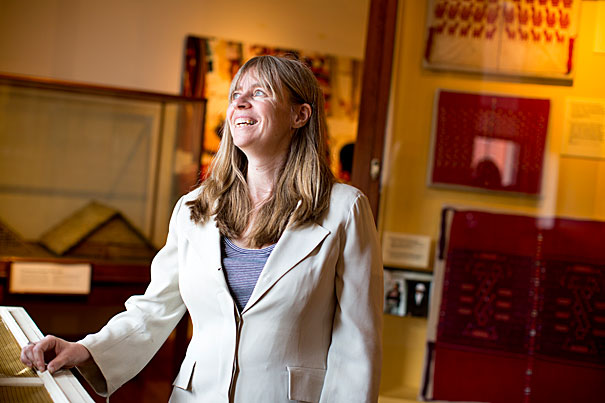
“Where I think we’re ahead of the curve is that we have brought together several diverse museums on one campus. They represent disciplines that historically have been separate, so tying them together wouldn’t have happened 50 years ago,” said Harvard Museums of Science and Culture Executive Director Jane Pickering.
Rose Lincoln/Harvard Staff Photographer
Collaborative museums
Consortium of six in science and culture celebrates stellar first year
Harvard Museums of Science & Culture (HMSC) celebrated the first day of summer with free admission, solar-telescope viewing from the roof observatory of the Science Center, and music and dancing on the Science Center Plaza. Not only was it a party, it was also a reflection of the successful public programming being developed by the six-museum consortium formed last summer.
Judging by the hundreds who came to celebrate the summer solstice, the creation of HMSC is proving a success.
“Where I think we’re ahead of the curve is that we have brought together several diverse museums on one campus. They represent disciplines that historically have been separate, so tying them together wouldn’t have happened 50 years ago,” said HMSC Executive Director Jane Pickering.
Last spring, Faculty of Arts and Sciences (FAS) Dean Michael D. Smith, in collaboration with faculty leaders of the individual museums, announced the consortium as a way to present collections from a wide variety of research areas.
The participating museums are the Collection of Historical Scientific Instruments, the Mineralogical and Geological Museum, the Harvard Semitic Museum, the Harvard University Herbaria, the Museum of Comparative Zoology, and the Peabody Museum of Archaeology and Ethnology. The consortium also includes the Harvard Museum of Natural History, which is the public face of the Mineralogical and Geological Museum, the Harvard University Herbaria, and the Museum of Comparative Zoology.
Each individual museum retains a strong connection to its respective academic department.
“I have never seen museums from all these diverse disciplines coming together while retaining the connection to the departments, and research and scholarship. It is a very sensible strategy, and one I think people are to watching to see what we are doing,” said Pickering, who came to Harvard last fall from Yale University. “While several universities with multiple museums have developed collaborations on specific activities, no one has created a new department to bring together the public activities in a holistic way. We’re charting new territory.”
HMSC is a reflection and extension of the University’s academic mission, and it is proving to be quite popular. Since the consortium’s official formation last July, a record number of visitors — more than 230,000 — have come to view the museums’ exhibits, participate in programs, and listen to free evening lectures. The consortium has welcomed visitors from the 50 states and 129 countries.
“The Harvard Museums of Science and Culture is a platform designed to facilitate new collaborations and exciting public programs across our museums, some of the great treasures on Harvard’s campus,” said Smith, the John H. Finley Jr. Professor of Engineering and Applied Sciences. “I’m delighted that, through HMSC, the public has a window into Harvard’s extraordinary museum collections and the cutting-edge research and teaching they enable.”
The holdings of the research museums of HMSC are vast and diverse, from Benjamin Franklin’s experimental instruments to rare minerals to millions of cultural artifacts. But HMSC is now working to bring the highlights of these diverse collections together for truly public exhibitions, expanding the scope and interpretation in a way never imagined when the Glass Flowers opened to the public in 1893.
“You can’t understand the world unless you understand it from a multidisciplinary perspective. That is the way research and scholarship continues to go, so therefore the museums’ public face follows that,” Pickering said. “The whole purpose of a university museum is that you are connected to the research and collections at the university, so if you are not presenting that multidisciplinary approach to the public, you are doing yourself and the public a disservice.”
The “Time & Time Again” exhibition at the Collection of Historical Scientific Instruments is a strong example of that cross-disciplinary approach. Portable sundials and precision clocks; calendars from different cultures and epochs; time charts shaped like animals; Mesopotamian, Native American, and African ritual objects; fossils; and metamorphosing creatures from the various collections show how humans have perceived time over the centuries.
“We have the engagement of the faculty in the maturation of the public face of the museums, which is very exciting, and the sense of enthusiasm is palpable across the range of disciplines. Literally within a stone’s throw from the museum, this top-flight research is taking place, and where the interdisciplinary view wouldn’t naturally arise in our own research, it is being tied together in the museum,” said James McCarthy, Alexander Agassiz Professor of Biological Oceanography, who chaired the Faculty Executive Board that worked to develop the consortium. “This consortium has been successful because the dean of the Faculty of Arts and Sciences not only showed a serious interest in doing this, but he gave the faculty the opportunity and the resources to rethink how the museums of FAS could be far more effective. The fact he gave us the opportunity is very much appreciated by the faculty.”
This new era of coordination of the exhibition and outreach programs of the museums is already providing opportunities for teaching and scholarship within Harvard and for visitors. Looking ahead, Pickering wants to create even greater opportunities.
“I have come across many alumni who said they never entered the museums in the four years they were here, and that has to change. We have to get every one of the undergraduates into these museums at some point over their four years, and not just those that come here for classes,” Pickering said. “The challenge is how can you get the students in here to have fun? This consortium is about raising awareness with the public, but also raising awareness on the campus.”




